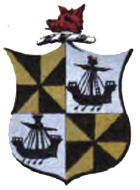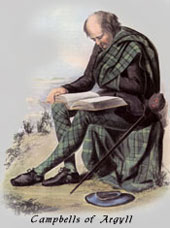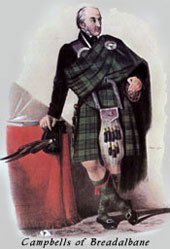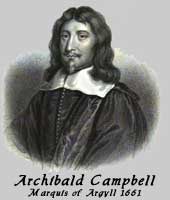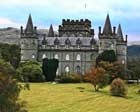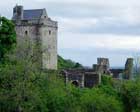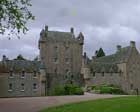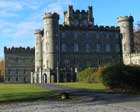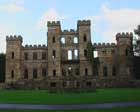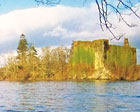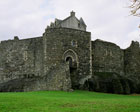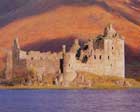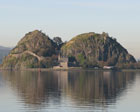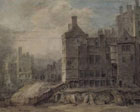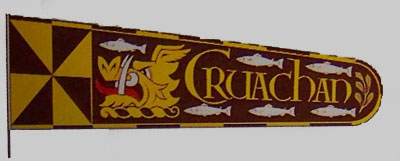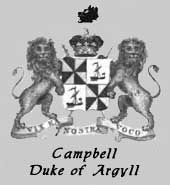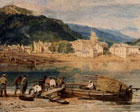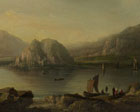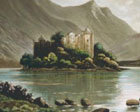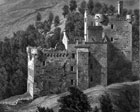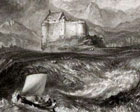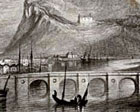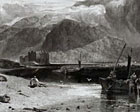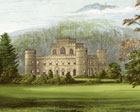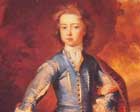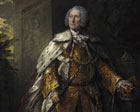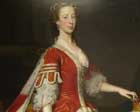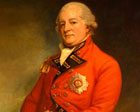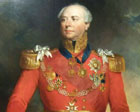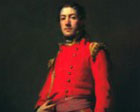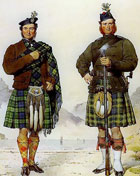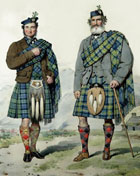 |
||
 |
||
Campbell ClanNe obliviscarus |
||||||
|
Clan Campbell information
|
||||||
 |
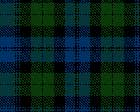 |
 |
||||
|
Clan crest badge |
Clan Castle |
Campbell tartan |
Clan Location |
|||
|
Castle Campbell |
Cawdor Castle |
Taymouth Castle |
Loudoun Castle |
|||
|
Innis Chonnel |
Dunstaffnage Castle |
Kilchurn Castle |
Dumbarton Castle |
|||
Clan HistoryClan Campbell is one of the older clans and during many periods in it's history was Scotland's most powerful. In the Crown Charter of 1368 the forefather of the Campbell Lords of Loch Awe is given as Duncan MacDuibhne. Duncan's son Colin was knighted by King Alexander 3rd in 1280. He was killed in 1294 fighting the MacDougall clan and from that day to this the Clan Chief is always referred to as MacCailean Mor ( son of Colin the great ). Colin's eldest son, Sir Neil Campbell supported Robert The Bruce in freeing Scotland from the English invasion and was rewarded with the lands of the Earl of Atholl. He also married Bruce's sister Mary. Sir Duncan's grandson, Colin, was created the Earl of Argyll in 1457. Two hundred years later the 8th Earl and 1st Marquis of Argyll was the leader of the Scottish anti-Royalists cause in the English Civil War - siding with Cromwell. When the monarchy was restored to full power in 1660 King Charles 2nd ( Mary Queen of Scots grandson ) ordered his beheading for treason and other crimes. His son the - now - 9th Earl fled to Holland and returned in 1685 to gather 1500 Campbell clansmen in support of the Duke of Monmouth in his claim to the crown. He was captured at Inchinnan and beheaded in Edinburgh in 1685. In the Jacobite uprisings the Campbells, with a few exceptions, were on the side of the British Army and more than any other clan helped defeat the resurrection of a Stuart monarchy. Inveraray Castle is the current seat of the Chief of Clan Campbell, Dukes of Argyll. The beautiful white walled castle is situated in a Royal Burgh and the blue-green granite it was built from, together with the slated towers that have weathered to a deep green give the castle an unreal fairy-tale look. Castle Campbell is near Dollar in Clackmannan. On the side of a hill it is hemmed in on both sides by the steep ravines and the burn of Care and the burn of Sorrow it was originally called Castle Gloom. The castle was built in the early 1400's as a Stuart stronghold. It originally came into the family through marriage in 1465. The Campbell's had to petition parliament to change the name. Cawdor Castle dominates the village of the same name, just east of Inverness. The central keep dates from 1454 and in early times was surrounded by a deep ditch and drawbridge. There are some older parts dating to 1386. Taymouth Castle in Perthshire is at the east end of Loch Tay. It was formerly the seat of the Campbell Earls of Breadalbane. The present castle dates back to 1801, it replaced the much older Balloch Castle on the same site which was built in 1550 for Sir Colin Campbell of Glenorchy. The great estates were split and sold after the first world war and the castle has had a few different uses. At present it is back in private ownership. Loudoun Castle is 5 miles from Kilmarnock in Ayrshire. The castle was the seat of the Campbell Earldom of Loudoun and the hereditary Sheriffs of Ayrshire. At one time it was mentioned as the most imposing castle on the west coast but after a serious fire in 1941 it is now a sad and neglected ruin. The surrounding lands have been converted into a leisure park and golf course. Ardchonnel Castle is a ruin located on the island of Innis Chonnell in Loch Awe. It's exact beginnings are misted in time but certainly from 1308 it was the Campbell clan seat for 200 years until the seat was transferred to Inveraray. Carnasserie Castle is 2 miles north-west of Kilmartin. It was built in 1565 by the local minister, later to be known as Bishop of the Isles John Carswell. On his death in 1572 the castle passed to the landlord the Earl of Argyll. In 1643 it was sold to Sir Dugald Campbell Baron of Auchinbreck. As a result of the insurrection supported by the 9th Earl, against King James the 7th, the castle was captured and demolished in 1685. In the 1800's the castle was sold to the Malcolm's and is now owned and looked after by Historic Scotland. Carrick Castle situated on the west shore of Loch Goil. Built in the 12th century it was captured and destroyed by fire in 1685. Craignish Castle Dunstaffnage Castle located 5 miles north of Oban. It was originally a MacDougall castle which Robert the Bruce seized in 1308 when he took his revenge on the clan. Bruce made it a Royal castle and put it in the care of the Campbells. The castle was greatly enlarged in the 15th century on the orders of King Alexander 2nd in preparation for his attack on the Norse Hebrides. Dumbarton Castle is on the north shore of the Firth of Clyde. There has been a fortification there since 440-460 A.D. The name Dunbarton derives from "fortress of the Britons". Kilchurn Castle is at the north-east end of Lock Awe. The castle was built in 1440 by Sir Colin Campbell of Glenorchy the first Earl of Breadalbane. The Campbells being anti-Jacobite offered the castle as garrison for Hanoverian troops in 1746. Meggernie Castle is to the north of Loch Tay, two miles west of Taymouth castle (as the crow flies ) or about eight miles by road. Originally taken from the MacGregors and given to his illegitimate son by King David 2nd - a Stewart. It was passed to Duncan Campbell in the beginning of the 17th century. Skipness Castle Strachur Castle Sween on Loch Sween, Knapdale Argyll. It was probably built around the 12th century and is one of the earliest stone castles in Scotland built in the Norman style with large angled buttresses. The castle was improved through the years keeping up with changes in technology but in 1647 it was destroyed by Sir Alexander MacDonald, one of Montrose's commanders. Cessnock Castle Kilsyth Castle sits on rocks surrounded on three sides by the Ardoch burn and is 3 miles north of Dunblane. The castle together with it's Barony was bought from the Graham family in 1669 by Sir Colin Campbell of Aberuchill. Originally built in 1460 it has been rebuilt in keeping with the times and the present structure is a small Baronial Mansion dating back to the 1870's. It is the home of Sir James Campbell and earns it's keep as a wedding venue. 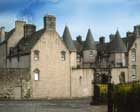 By the 17th century it became more convenient for the Earl's and later Dukes of Argyll to have lodgings nearer the seats of power at Edinburgh and Stirling castle. Argyll's Lodging, in Stirling, still stands today and is described as the best remaining 17th century town house in Scotland. |
||||||
|
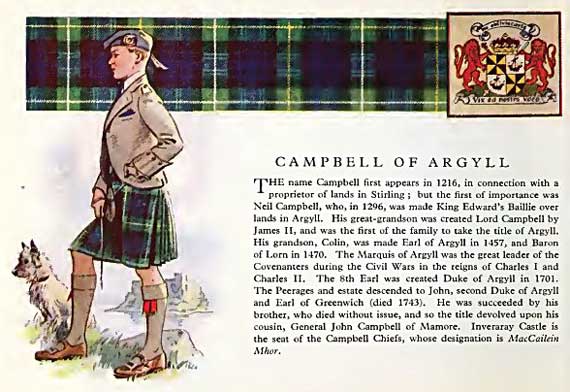 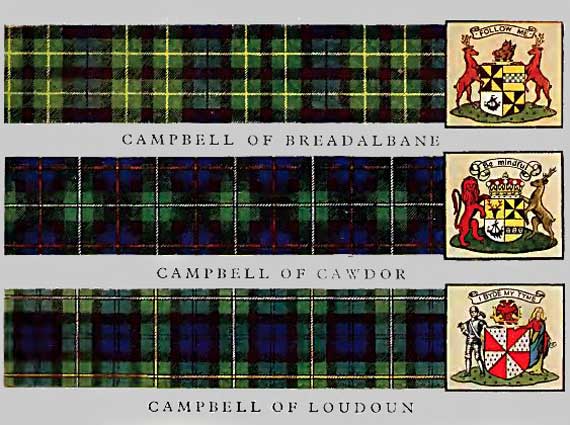 |
||||||
